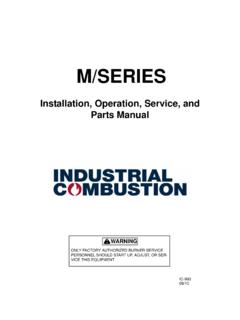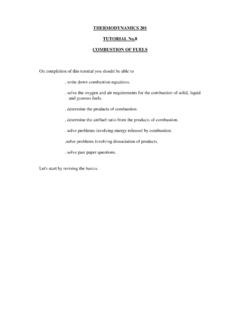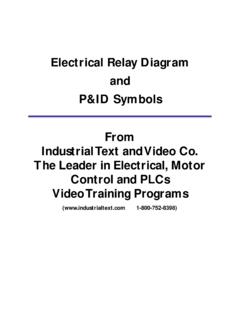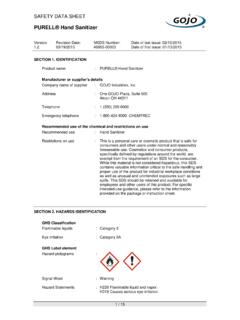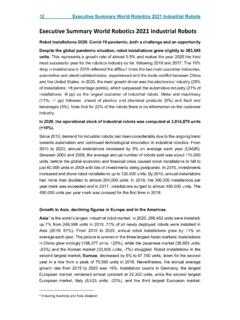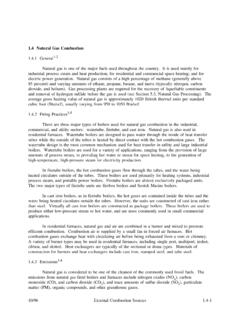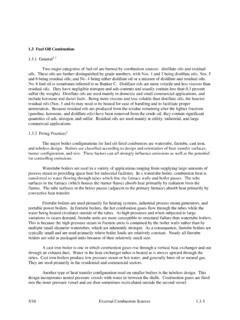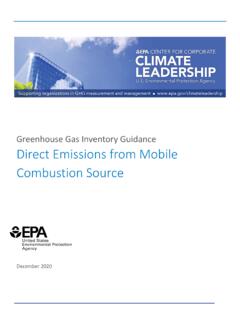Transcription of Industrial Technologies Program - Energy
1 A BestPracticesSteam TechnicalBriefIndustrialHeat Pumpsfor Steamand Department of EnergyEnergy Efficiency and Renewable EnergyBringing you a prosperous future where Energy is clean, abundant, reliable, and affordableEnergy efficiency and clean, renewable Energy will mean a stronger economy, a cleaner environment, and greater energyindependence for America. By investing in technology breakthroughs today, our nation can look forward to a more resilient economy and secure technology changes will be essential to America senergy future. Working with a wide array of state, community,industry, and university partners, the Department of Energy sOffice of Energy Efficiency and Renewable Energy invests in adiverse portfolio of Energy Technologies that will: Conserve Energy in the residential, commercial, Industrial , government, and transportation sectors Increase and diversify Energy supply, with a focus on renewable domestic sources Upgrade our national Energy infrastructure Facilitate the emergence of hydrogen Technologies as a vital new Energy carrier.
2 The OpportunitiesBiomass ProgramUsing domestic, plant-derived resources to meet our fuel, power,and chemical needsBuilding Technologies ProgramHomes, schools, and businesses that use less Energy , cost less tooperate, and ultimately, generate as much power as they useDistributed Energy & Electric Reliability ProgramA more reliable Energy infrastructure and reduced need for newpower plantsFederal Energy Management ProgramLeading by example, saving Energy and taxpayer dollars in federalfacilitiesFreedomCAR & Vehicle Technologies ProgramLess dependence on foreign oil, and eventual transition to an emisions-free, petroleum-free vehicleGeothermal Technologies ProgramTapping the earth s Energy to meet our heat and power needsHydrogen, Fuel Cells & Infrastructure Technologies ProgramPaving the way toward a hydrogen economy and net-zero carbonenergy futureIndustrial Technologies ProgramBoosting the productivity and competitiveness of industrythrough improvements in Energy and environmental performanceSolar Energy Technology ProgramUtilizing the sun s natural Energy to generate electricity and providewater and space heatingWeatherization & Intergovernmental ProgramAccelerating the use of today s best Energy -efficient and renewabletechnologies in homes, communities, and businessesWind & Hydropower Technologies ProgramHarnessing America s abundant natural resources for clean powergenerationTo learn more, visit ,PLEASECONTACT:DOE Information ClearinghousePhone: (800) 862-2086 Fax.
3 (360) our home page send any comments,questions, or suggestions Technologies ProgramEnergy Efficiency and Renewable Department of EnergyWashington, DC 20585-0121 Industrial Technologies ProgramDOE/GO-102003-1735 June 2003 Boosting the productivity and competitiveness of industry through improvements in Energy and environmental performanceA STRONGENERGYPORTFOLIO FOR ASTRONGAMERICAACKNOWLEDGEMENTS:The Industrial Technologies Programwould like to thank Andrew McMullan,Veritech Inc., for writing this BestPracticesSteam Technical Brief, and theBestPractices Steam technical subcommittee for reviewing Heat Pumps for Steam and Fuel Savings1 Industrial Heat Pumps forSteam and Fuel SavingsIndustrial heat pumps are a class of active heat-recovery equipment that allows the temperatureof a waste-heat stream to be increased to a higher, more useful temperature. Consequently, heatpumps can facilitate Energy savings when conventional passive-heat recovery is not purpose of this Steam Technical Brief is to introduce heat-pump technology and its application in Industrial processes.
4 The focus is on the most common applications, with guidelinesfor initial identification and evaluation of the opportunities being INTRODUCTION TO HEAT PUMPSA heat pump is a device that can increase the temperature of a waste-heat source to a temperaturewhere the waste heat becomes useful. The waste heat can then replace purchased Energy and reduceenergy , the increase in temperature is not achieved without cost. A heat pump requires anexternal mechanical- or thermal- Energy source. The goal is to design a system in which the benefitsof using the heat-pumped waste heat exceed the cost of driving the heat pump. Several heat-pump types exist; some require external mechanical work and some require externalthermal Energy . For the purpose of discussing basic heat-pump characteristics, this brief will firstintroduce the mechanical variety, and then address the thermal Why can a heat pump save money?Heat pumps use waste heat that would otherwise be rejected to the environment; they increaseair temperature to a more effective level.
5 Heat pumps can deliver heat for less money than the cost of fuel. Heat pumps operate on a thermodynamic principle known as the Carnot Cycle. To aid understanding of this cycle, it is helpful to contrast the Carnot Cycle with the more familiar thermodynamic cycle that underlies the operation of steam turbines, the Rankine Cycle. Degrading high-grade thermal Energy into lower-grade thermal Energy creates shaft work, orpower, in the Rankine Cycle. In a steam turbine, this is accomplished by supplying high-pressuresteam and exhausting lower-pressure contrast, mechanical heat pumps operate in the opposite manner. They convert lower-temperature waste heat into useful, higher-temperature heat, while consuming shaft work (Figure ).The work required to drive a heat pump depends on how much the temperature of the wasteheat is increased; in contrast, a steam turbine produces increasing amounts of work as the pressurerange over which it operates increases. Heat pumps consume Energy to increase the temperature of waste heat and ultimately reduce theuse of purchased steam or fuel.
6 Consequently, the economic value of purchasing a heat pumpdepends on the relative costs of the Energy types that are consumed and Heat Pumps for Steam and Fuel How does a heat pump work, and how much Energy can it save?Several types of heat pumps exist, but all heat pumps perform the same three basic functions: Receipt of heat from the waste-heat source Increase of the waste-heat temperature Delivery of the useful heat at the elevated of the more common heat pump types, the mechanical heat pump, will be used to showhow these functions work (Figure ).2 Figure : Comparison of Steam-Turbine and Heat-Pump Operating PrinciplesSteam: Higher PHeat: Higher TSteam: Lower PHeat: Lower TSteamTurbineHeatPumpWorkWorkHeat SinkHeat Delivered by Heat Pump = Qe + WProcess StreamBeing HeatedCondenser (Heat Delivered Here)TcTeCompressorWorkWExpansion ValveEvaporator (Heat Accepted Here)Waste-Heat StreamBeing CooledHeat SourceHeat Delivered to Heat Pump = Qe1. Waste-heat stream evaporates heat-pump working fluid at low temperature and pressure2.
7 Compressor increases pressure of heat-pump working fluid3. Heat-pump working fluid condenses at high temperature and pressure in the condenser, providing useful heat to a process stream 4. Condensed working fluid is expanded back to the evaporatorFigure : Simple Schematic of Mechanically Driven Heat PumpP = PressureT = TemperatureQe=Waste-heat duty deliveredto heat pumpTc=Condenser operating temperatureTe=Evaporator operating temperatureW=Work supplied to operateheat-pump compressorIndustrial Heat Pumps for Steam and Fuel SavingsWaste heat is delivered to the heat-pump evaporator in which the heat-pump working fluid isvaporized. The compressor increases the pressure of the working fluid, which in turn increases thecondensing temperature. The working fluid condenses in the condenser, delivering high-temperatureheat to the process stream that is being heated. A key parameter influencing the savings that a heat pump achieves is the temperature lift realized in the heat pump.
8 Temperature lift is the difference between the evaporator and condensertemperatures. Figure illustrates how the cost of heat delivered by an electric-motor-driven mechanical heatpump depends on the cost of electric power and on the temperature lift that the heat pump example, if natural gas costs $ British thermal units (MMBtu), the cost of deliveringheat from fuel at 80% efficiency will be $ Figure shows that the effective cost of heatsupplied by the heat pump is lower than the cost of purchased fuel that otherwise would be con-sumed. However, this advantage erodes as the temperature lift increases, because more work isrequired to obtain the higher lifts. Also, because electricity is the work source for this heat pump,lower power costs result in greater the right circumstances, a heat pump can reduce Energy costs and provide an attractivecost-reduction project, particularly when: The heat output is at a temperature where it can replace purchased Energy such as boiler steam or gas firing The cost of Energy to operate the heat pump is less than the value of the Energy saved The net operating cost savings (reduction in purchased Energy minus operating cost) is sufficient to pay back the capital investment in an acceptable time Industrial applications, simple paybacks of 2 to 5 years are typical.
9 Different types of heatpumps accomplish the three basic heat-pump functions in different ways, but in all cases the goal is3xxxxxxxxPower Cost, Temperature Lift ( F)Cost of Delivered Heat, $/MMBtuChart basis: Heat-pump evaporator temperature = 120 F Efficiency of heat-pump cycle is 65% thermodynamic maximum Information is intended only to present trends, and will not apply to all : Comparison of Cost of Heat DeliveredIndustrial Heat Pumps for Steam and Fuel Savingsthe same: recover waste heat, increase its temperature, and deliver it at a higher, more useful, temperature for a reduced cost compared to the alternative. The common variants are described Common types of Industrial heat pumpsA brief description of the most common types of heat pumps and their key operating principlesis provided Mechanical Heat Pumps use mechanical compression of a working fluid to achievetemperature lift. The working fluid is typically a common refrigerant.
10 Most common mechanicaldrives are suitable for heat-pump use; examples include electric motors, steam turbines, combustionengines, and combustion Mechanical Vapor Compression (MVC) Heat Pumps use a mechanical compressorto increase the pressure of waste vapor. Typically used in evaporators, the working fluid is watervapor. MVC heat pumps are considered to be open cycle because the working fluid is a processstream. Most common mechanical drives are suitable for heat-pump use; examples include electricmotors, steam turbines, combustion engines, and combustion Thermocompression Heat Pumps use Energy in high-pressure motive steam toincrease the pressure of waste vapor using a jet-ejector device. Typically used in evaporators, theworking fluid is steam. As with the MVC Heat Pump, thermocompression heat pumps are open Absorption Heat Pumps use a two-component working fluid and the principles ofboiling-point elevation and heat of absorption to achieve temperature lift and to deliver heat at highertemperatures.










